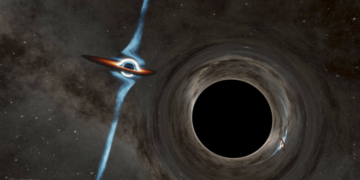This is an illustration from Caltech shows how two black holes are circling each other. Credit: Caltech-IPAC
<!–
This is an illustration from Caltech shows how two black holes are circling each other. Credit: Caltech-IPAC
–>
At a distance of some 9 billion light-years away, two massive black holes are dancing a cosmic waltz.
In a recent study published in The Astrophysical Journal Letters, the black holes are called PKS-2131-021 and they are closely orbiting around each other — so close, says NASA, that they are almost 100 percent merged.
They get closer and closer every two years, and will be completely merged together in about 10,000 years. This may seem like a long time but it usually takes about 100 million years for black holes this large to even start orbiting one another. NASA says these black holes are millions if not billions of times the mass of our Sun.
PKS-2131-021 is one of 1,800 black holes that a team of researchers at Caltech have been monitoring for 13 years in the Owens Valley Radio Observatory near Big Pine, California.
“A black hole is a very special thing. It is something that once existed only in mathematics as a consequence of Einstein’s theory of relativity” said Michele Vallisneri, who works at NASA’s Jet Propulsion Laboratory in Southern California and co-authored the recent study. “It seemed quite extreme impossible — like one of those predictions that you get out of mathematics [that] should not exist.”
In 2016 astronomers at Caltech were studying gravitational waves which are in invisible ripples in space produced whenever there is a drastic change in mass. While searching for these ripples, they detected two black holes near each other. However, the black holes exhibited strange behavior due to the irregular brightness, and to confirm that these black holes were circling each other they had to pull data from 2008 to 2019.
“The simplest explanation that we have for these observations is that these are two black holes that are very big and very close,” said Vallisneri.
Black holes don’t emit light, but Vallisneri said that they were able to detect these black holes because they were swallowing the surrounding matter very rapidly and emitting light through colliding stars near the black holes.
“We understand that they are so luminous because, at the very center, there’s a black hole that is gobbling accreting lots of matter very rapidly from the surroundings,” said Vallisneri. “That gas gets very hot, and produces lots of radiation”
PKS-2131-021 is considered a special type of black hole known as a blazer — a black hole that is spewing a jet of supercharged matter towards Earth (but there’s no need to worry, it won’t affect our planet). The matter comes from hot gas that is around the black holes and instead of having the matter come towards the black hole, it is traveling through the galaxy at the speed of light.
“The regular gravitational radiation from the orbit, we will see it in a few years as we collect more and more radio data,” said Vallisneri.
The merger of two black holes is not unusual, it just takes a long time for black holes to get into orbit with one another.
“Those two black holes will keep orbiting each other at a respectable distance without ever coming close enough to merge. But we do think that many of them will.”
In 2037 NASA and the European Space Agency will be sending a trio of spacecraft called the Laser Interferometer Space Antenna, or LISA, millions of miles into the galaxy. LISA will be able to detect and measure gravitational waves of these colliding black holes.
“If everything goes well, you should see hundreds of those mergers within the five to 10 years of its operation,” Vallisneri said.
!function(f,b,e,v,n,t,s)
{if(f.fbq)return;n=f.fbq=function(){n.callMethod?
n.callMethod.apply(n,arguments):n.queue.push(arguments)};
if(!f._fbq)f._fbq=n;n.push=n;n.loaded=!0;n.version=’2.0′;
n.queue=[];t=b.createElement(e);t.async=!0;
t.src=v;s=b.getElementsByTagName(e)[0];
s.parentNode.insertBefore(t,s)}(window,document,’script’,
‘https://connect.facebook.net/en_US/fbevents.js’);
fbq(‘init’, ‘169540813993526’);
fbq(‘track’, ‘PageView’);




